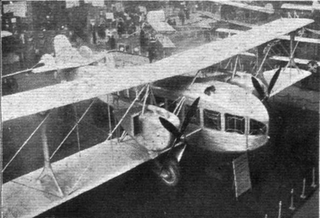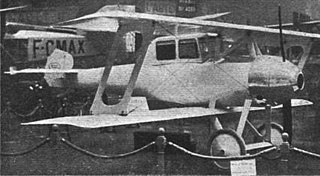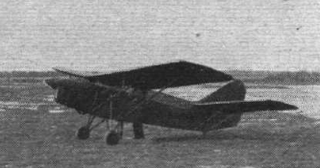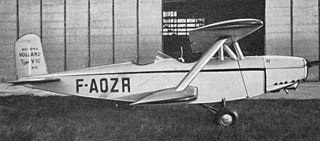
The Potez 37 was a two-seat, long range reconnaissance aircraft built to compete for a French government contract. It flew in mid-1930 but did not win the competition, so only two were completed.

The Bréguet Leviathan was a family of large all-metal biplane aircraft built in France in the early 1920s. The Bréguet XX and XXI were notable for being powered by Bréguet-Bugatti multiple engines, in two forms. The Bréguet XXI was powered by individual Bréguet-Bugatti U.16 engines initially and Lorraine-Dietrich 8b engines in tandem later. The Bréguet XXII had accommodation for about twenty passengers and was destroyed during a 1923 transport aircraft competition. Development of all three aircraft types was halted largely due to technical issues with power-plants and aircraft structure.
The Potez 26 was a single seat fighter aircraft designed and flown in France in the mid-1920s. It did not reach production.
The Potez 27 was a French reconnaissance biplane first flown in 1924. 175 were operated by the Polish Air Force, most built in Poland by PWS under licence. Others went to Romania, where they were also used as light bombers.

The Caudron C.27 was a French biplane, a two-seat basic trainer which also competed successfully in the 1920s.
The Caudron C.99 was a French light bomber and reconnaissance aircraft. The only example flew with different engines in the mid-1920s.

The de Marçay Passe-Partout was a small, low-powered single-seat sport and touring aircraft built in France just after World War I.

The de Marçay Limousine was a two-seat French touring biplane introduced at the 1919 Paris Aero Salon. A smaller but otherwise very similar single-seater was also there.

The Albessard Triavion, sometimes known as the Peyret-Albessard Triavion, was a three surface aircraft, combining a tandem wing and conventional tailplane.

The Villiers IV or Villiers 4 was a French two seat naval floatplane. Two were built, the first with twin floats and the second with one. The first was short-lived but the second set several world and national records; it later became the Villiers XI.

The SFCA Maillet 20 was a French three seat tourer built in 1935. The Armée de l'Air ordered 30 for training and liaison and several were raced. The aircraft was developed through 1935 via cockpit layout and canopy changes to the provision of retracting landing gear.

The SFCA Taupin was a French tandem-wing aircraft, designed to provide a simple, stable and safe aircraft able to take-off and land in small spaces.

The Delanne 11 was a French two seat touring aircraft. Only one was built.
The Delanne 60-E.1 was a training sailplane, designed to enable pilots to graduate from their C certificate to the more demanding D. It was also capable of aerobatics. Only one was built but it was used from 1938 to the outbreak of war.

The Volland V-10 was a French two seat, low-powered biplane notable for its extreme stagger. It first flew in 1936 and appeared at the Paris Aero Salon that year.
The Caudron C.860 was a single engine, single seat monoplane ordered by the French government as a long distance communications aircraft. First flown in 1938, it was also expected to set speed and altitude records but the outbreak of World War II ended developments.

The Weymann-Lepère WEL-80 R.2 was a French two seat reconnaissance aircraft built to compete for a 1928 government contract. It was not successful and did not enter production.

The Nieuport-Delage NiD 580 R.2 was a contender for a French government contract for a long range, two seat reconnaissance aircraft, issued in 1928. There were eight prototypes in the 1931-2 contest and the NiD 580 was not selected for production.

The SECM-Amiot 130 R.2 was a contender for a French government contract for a long range, two seat reconnaissance aircraft, issued in 1928. There were eight prototypes in the 1931–32 contest and the Amiot 130 was not selected for production.
The Morane-Saulnier MS.300 and MS.301 were French parasol wing introductory trainer aircraft, first flown in 1930. They differed only in engine type. Neither reached production but were developed into two similar trainers, the MS.230 and MS.315, which were made in large numbers.















